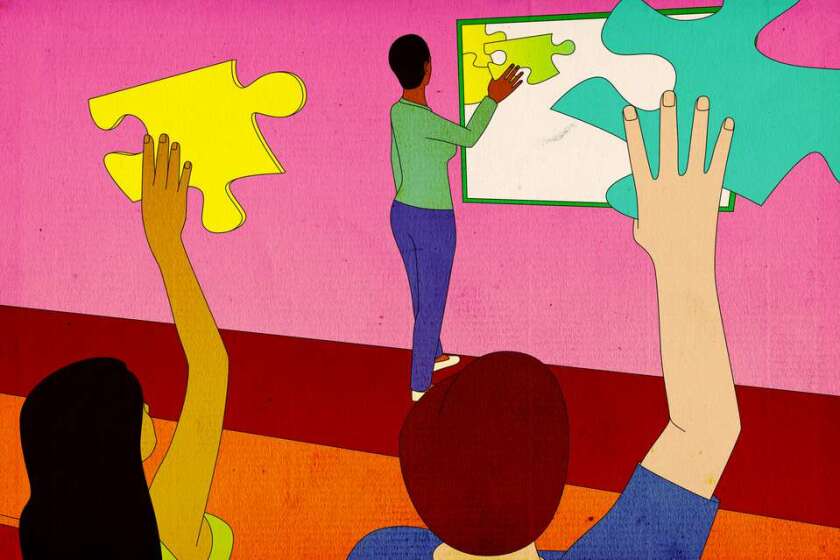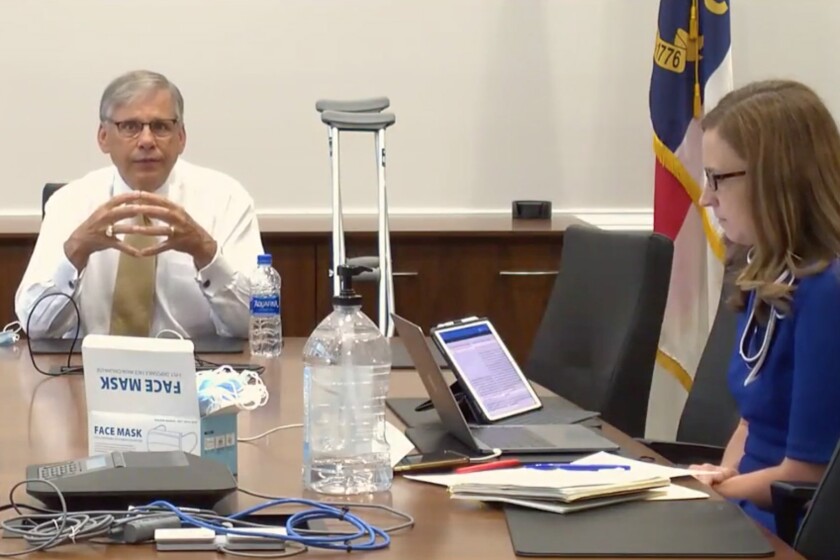ACADEMIC CULTURE
By Beth McMurtrie
There’s a whole literature on what works. Why don’t more instructors act on it?
Blog para comentarios sobre educación continua y nuevos desafíos para estudiantes y profesionales de la Contaduría Pública... Grupo de Investigación Contable. 2025 By Javier E. Miranda R., CPA, CGF, MADE, MTE.
ACADEMIC CULTURE
By Beth McMurtrie
There’s a whole literature on what works. Why don’t more instructors act on it?
LEADERSHIP
By Lee Gardner
What makes one a success and another a waste of time?
Instructors headed to a reopened campus this fall won’t be the only ones in their classrooms feeling a bit nervous. Your students probably aren’t so sure about how well prepared they are after more than a year spent under Covid restrictions. Many of them learned mostly online and largely alone. And while high-school teachers and college professors may have adjusted their content and teaching strategies to help, that might mean students now worry about what they need to do to adapt or catch up.
So how can you quickly assess where your students are, both in terms of what they know and how they feel about being back on campus? Kelly Hogan, a teaching professor of biology at the University of North Carolina at Chapel Hill, and associate dean of instructional innovation, has a few ideas.
I called Hogan after reading a recent thread she wrote on Twitter, asking her to elaborate. Here’s a summary of her advice.
Send out a survey before the first day of class. This is a good opportunity to ask students about two things: what experience they have with the content of your course and how they feel about returning to in-person learning. In her foundational course, for example, Hogans asks students when they last took biology. She already knows the answer: It was usually ninth grade. But this gives students the chance to tell her that they haven’t studied biology in a *really* long time, which helps reassure them that she now knows this. She also asks what they’re nervous about. For some this year, it’ll be the prospect of showing up to an in-person class, or perhaps not having the opportunity to rewind a pre-recorded lecture. Understanding students’ concerns, Hogan says, can help instructors think about how to adapt their teaching this fall.
Give a nongraded assessment. Sometimes, Hogan notes, if you give students an assessment before the course starts they might Google the answers. But if you do this during the first or second day of class, you’ll get a more accurate view of what students know and remember. Then, use the results to adjust your course goals as needed. Let students know that you’re not testing them in a formal sense, but are simply trying to figure out where they are. Hogan suggests reaching out to your campus teaching-and-learning center if you’re not sure how to structure such an assessment.
Provide resources to review. Many instructors taped their lectures this past year, so they could consider offering relevant ones to incoming students looking for review material. Or if your department has a suite of videos for, say, Chemistry 101, you could use those, or materials found on YouTube. Hogan is also planning to give her students a first assignment that is something of a how-to: how to use the technology, an introduction to the textbook, and where to go to find other study resources.
Set clear expectations. Hogan ties this back to the student survey. Many students have already expressed anxiety about a return to face-to-face teaching. So on your syllabus, let them know what to expect in terms of deadlines, assignments, and tests. Hogan plans to keep open-note tests in the course she is co-teaching this fall. And she will continue to offer flexibility with deadlines by giving students tokens that allow them to turn things in late on occasion.
Another area instructors might want to consider adjusting this fall: their syllabus.
In this Twitter thread, Matt Johnson, an associate professor in the department of educational leadership at Central Michigan University, lists 10 things faculty should re-evaluate as they prepare for “another hellish and difficult semester for students spurred by our inability to control the virus.”
Among Johnson’s suggestions: Don’t link grades to attendance, de-emphasize group work, avoid penalizing students for turning in assignments late, and have someone read through your syllabus to ensure that you “sound like a human being invested in students’ success and well-being.”
NEW SEMESTER How to Teach a Good First Day By James M. Lang  The first day of class is crucial both for your students and for you. This guide will help you make opening day as effective as possible. |
MIT and Harvard Have Sold Higher Education’s Future
By Jefferson Pooley

Handing over edX to a private company is a gross betrayal.
PAID FOR AND CREATED BY CAPELLA UNIVERSITY
Prior Learning Assessment allows schools to give students credit for prior work and life experience. Expanding its application could help improve equity in education.
By Samuel J. Abrams  Professors have talked a lot about the downsides of online synchronous teaching, but it’s had some benefits, too. |
En línea,
todos los estudiantes no están en la primera fila
Deborah Beck se enorgullece de dirigir un aula atractiva. Su
curso de “Introducción a la mitología clásica” en la Universidad de Texas en
Austin atrae principalmente a estudiantes de primer y segundo año, muchos de
los cuales están allí para satisfacer un requisito de ética, cultura global o
artes.
Su enseñanza, dice, depende en parte de poder leer en la
sala para poder modelar los tipos de aprendizaje que le gustaría que hicieran
sus alumnos. Eso significa crear espacio para que sus estudiantes, y ella misma,
se equivoquen y aprendan de sus errores. También significa hablar de los mitos
antiguos de forma que se relacionen con los dilemas éticos de la actualidad.
Ese tipo de discusiones matizadas son un gran impulso en cualquier entorno,
pero, según Beck, son particularmente difíciles en línea.
¿Qué sucede cuando tienes un registro de 200 estudiantes? ¿cómo
hizo Beck, profesor asociado en el Departamento de Clásicos, la primavera
pasada, y con solo dos profesores asistentes? ¿Cómo se adapta cuando sus
estudiantes están distraídos y luchando debido a Covid y una tormenta de hielo
masiva en Texas que dejó a millones sin electricidad?
¿Qué hace cuando la tecnología de la sala de reuniones no
funciona como se supone que debe hacerlo, durante varias semanas seguidas? ¿Y cómo
involucras a los estudiantes que son en su mayoría cuadrados negros en una
pantalla?
“Todos los estudiantes no están en absoluto en la primera
fila de mi clase, en absoluto”, dice Beck.
Ese comentario fue en reacción a algo que escribí un par de
semanas antes, cuando describí a Eric Mazur, un profesor de física en Harvard
que se había convertido en un entusiasta converso a la enseñanza en línea. Sus
clases eran más íntimas, las conversaciones más sostenidas, el trabajo más
fuerte y los estudiantes más satisfechos, me dijo. “Cuando enseñas en línea,
todos los estudiantes están sentados en la primera fila. Hay una conexión que
nunca antes había tenido con los estudiantes ".
Resulta que mi historia debería haber venido con una
advertencia de activación.
Beck se acercó después de leer el artículo para señalar que
una experiencia como la de Mazur depende en gran medida de los recursos y los
privilegios. Muchos miembros de la facultad están enseñando una gran cantidad
de cursos, tienen altos requisitos de servicio o son adjuntos, lo que hace
imposible dedicar tanto tiempo como él a desarrollar y ejecutar su curso. Es
posible que tengan pocos o ningún ayudante de enseñanza y muchos estudiantes
que luchan con la tecnología irregular, lo que hace que sea casi imposible
tener discusiones significativas en los denominados Zoom Rooms.
Beck se considera una de las más afortunadas. Ella es
titular y solo estaba enseñando un curso en la primavera, gracias al tiempo
extra que le dieron para trabajar en un libro (que se retrasó debido a las
demandas de este curso). Sin embargo, a menudo se sintió bloqueada durante el
semestre.
"Estoy orgullosa de la comunidad que creamos y del
aprendizaje que fomentamos", dice. “Pero fue al menos el doble de trabajo
con el mismo resultado que obtengo en un salón de clases en persona. Y no fue
un mejor trabajo, solo fue un trabajo ".
Beck y yo hablamos sobre lo que aprendió sobre la enseñanza
en línea durante una pandemia. Aquí hay algunas conclusiones.
Crear un curso en línea requiere una cantidad extraordinaria
de trabajo. Beck dedicó más de 270 horas a este curso, según el análisis de
Canvas. Eso no incluye más de 50 horas creando videos, buscando recursos en
línea para estudiantes, respondiendo correos electrónicos, etc.
En las grandes clases en línea, hay un tiempo limitado para
interactuar con grupos pequeños de estudiantes. Con 20 a 22 salas para grupos
en cada clase, Beck descubrió que ella y sus dos asistentes de enseñanza solo
podían revisar rápidamente cada sala para asegurarse de que todo funcionaba
correctamente. De vez en cuando, por ejemplo, solo encontraban a un estudiante
porque el resto del grupo no se presentaba. De lo contrario, se involucraron
con los estudiantes al monitorear su trabajo compartido en Google Docs y
comentar según fuera necesario.
Los sentimientos de los estudiantes también variaron sobre
las discusiones del curso, dijo. Algunos amaban a sus grupos Zoom; otros se
sentaron en gran parte en silencio. "Eso es lo que habría podido arreglar
si pudiera visitar a cada grupo", dice. "No era posible para mí
siquiera saberlo".
La interacción significativa es difícil. Aunque su curso es
extenso, Beck estima que llega a conocer bien a una cuarta parte de sus
estudiantes cuando enseña en persona. Esta vez, su capacidad para formar
cualquier tipo de conexión fue mucho más débil. Con los estudiantes llenando
hasta cinco páginas de la cuadrícula de Zoom, y la gran mayoría manteniendo sus
cámaras apagadas, Beck habló principalmente al vacío. "El veinte por
ciento está en la pantalla frontal de Zoom", dice. "El resto, nunca
los vas a ver".
Beck dice que sus estudiantes tampoco podrían beneficiarse
tanto del aprendizaje a través de la interacción de toda la clase porque ella
no podía leer en la sala. Por lo general, fomenta la discusión en parte
midiendo las reacciones de los estudiantes, algo que solo pudo controlar con la
función de chat de Zoom.
La capacidad de los estudiantes para aprender se redujo
significativamente, incluso con un curso modificado. Al final del trimestre de
otoño, dice Beck, se hizo evidente que los estudiantes estaban agotados. Así
que redujo el plan de estudios de esta clase en más del 50 por ciento. También
renovó la estructura del curso para crear una rutina más semanal y aumentó el
énfasis en las tareas de menor importancia, con la idea de que estos cambios
ayudarían a contrarrestar el estrés del aprendizaje en línea en una pandemia.
Aun así, los estudiantes se sintieron abrumados. Encontraron
que la escritura de respuestas cortas era más desafiante, por ejemplo, y la
mecánica básica de una buena escritura, como tener una idea principal, seguía
siendo una lucha. También aprendió que los estudiantes odiaban las pruebas
semanales. "No valió la pena dividir los exámenes de mayor importancia en
los de menor importancia", dice, "porque seguía siendo estresante y
los beneficios no superaban los costos".
También sintió la ausencia de conexión física. En una clase
presencial, Beck dice que puede crear la sensación de que estamos todos juntos
en esto, lo que ayuda a motivar a los estudiantes. Pero no pudo lograrlo en
línea.
Beck descubrió que eso era especialmente cierto en una época
de crisis, cuando sus padres perdieron el trabajo, sus hermanos se enfermaron y
sus hogares se quedaron sin electricidad. “Esa fue la característica
definitoria del semestre para mí: cuán profundas fueron las pérdidas, el estrés
y la tristeza para mis estudiantes”, dice.
Continuará usando herramientas en línea, pero no cree que la
enseñanza en línea funcione para ella. Es probable que la pandemia retroceda en
el otoño y Beck se muestra ambivalente acerca de la enseñanza en línea
nuevamente. Le gusta la función de chat Zoom y otras herramientas, como los
foros de discusión diarios, pero parece poco probable que una clase
completamente en línea le proporcione lo que necesita.
“La infraestructura relacional del aula es tan fundamental
para la enseñanza que hago que las cosas buenas de la enseñanza en línea no son
suficientes para compensar la pérdida”, dice ella.
“Mi sensación anecdótica es que la gente tiende a usar
Internet para cosas que no les importan tanto o que no pueden hacer de otra
manera. Pero las cosas que realmente les entusiasman hacer, tienden a hacerlas
en persona. Tiendo a estar de acuerdo con eso ".
¿Funciona el aprendizaje invertido cuando los estudiantes
están trabajando?
Otro lector, que pidió permanecer en el anonimato, escribió
para decir que el aprendizaje invertido, en el que los estudiantes leen mucho y
hacen mucho trabajo fuera de clase, como lo hacen los estudiantes de Eric
Mazur, es un problema real para los estudiantes que mantienen trabajos.
"Nuestros estudiantes toman cuatro cursos por semestre,
y eso sería 40 horas de trabajo por semana según los cálculos de Eric",
escribió el lector. “Sin embargo, muchos de nuestros estudiantes trabajan de 20
a 40 horas a la semana en sus puestos de trabajo. Tuve que dejar de enseñar en
un aula invertida porque los estudiantes no tenían tiempo para hacer el trabajo
exterior ".
El trabajo en grupo fuera del aula es igualmente difícil,
señaló, debido a estas otras demandas en el tiempo de los estudiantes. El
lector agregó que cuando enseñaba a un alumnado más rico, el aprendizaje
invertido funcionaba mejor que la conferencia tradicional.
Eso me hizo pensar. ¿Ha tenido problemas con el aprendizaje
invertido cuando muchos de sus estudiantes tienen trabajos? ¿Ha descubierto una
forma de solucionar este problema?
ADVICE How to Cope With a Fear of By Irina Dumitrescu  Pressure has increased on scholars, especially junior ones, to add public writing to their arsenal of skills. |
Responsible for creating and sustaining your institutional culture, understand how issues such as remote work, physical safety and change management are being perceived by your faculty and staff.
Views |
IN CASE YOU MISSED IT The Concrete Benefits of a Virtual Conference By Leonard Cassuto  Yes, academics miss our in-person scholarly meetups. But the online version of the annual MLA convention had its own virtues. |
PAID FOR AND CREATED BY MODERNTHINK
An opportunity to engage with your employees, the Great Colleges to Work For program addresses pillars of engagement like communication, well-being, diversity and inclusion, helping you fulfill goals in your strategic plan.
IN CASE YOU MISSED IT Distracted Minds: Why You By James M. Lang |
Sometimes in teaching you have the right idea but — at first — the wrong way to go about it. That’s what happened to Vadim Keyser, an assistant professor of philosophy at California State University at Fresno.
Several years ago, Keyser was teaching an upper-division philosophy-of-science course, and wrestling with the idea of engagement in online courses. Specifically, how could he help his students, who were both science and nonscience majors, better understand the complex concepts he was teaching?
At first, says Keyser, who was then working at Cal State at Sacramento, he thought the best way might be to use his background in art and animation to create catchy videos: some animated, some in the clever style of Bill Nye. So, with the help of a grant, he created an experiment that he could run in different sections of his course.
But when test scores came back from his 200 or so students, he didn’t see any difference between those who had been given his creative tools and those who hadn't. That was puzzling to Keyser, who had been sure that “making cool stuff” was the way to better understand tricky scientific concepts.
Around the same time, he was also teaching a course in the honors college, on civic engagement and service learning. Those students worked on a large sculpture project for the community. It was “massively exciting” to the students, recalls Keyser.
After that first failed experiment, in 2013-14, and with the honors-college experience under his belt, Keyser had a small epiphany: Maybe his students, not he, should be the ones making things.
So he tried the experiment again, in 2015. Except this time, he asked students to work in groups and make something that visualized a concept they were learning. It could be a film, a conference presentation, or a graphic novel. It didn’t need to be sophisticated or high-tech. What mattered, he says, is that they worked together to analyze scientific information and visually represent it in a way that demonstrated their understanding.
When he tested his students, the scores among those who had created videos and visualizations were about 25 percent higher than those who had done traditional note-taking summaries. While it was a small experiment and a single test, Keyser says, it changed how he engages students in an online course.
“My initial thinking was that engagement was about exposure to information,” he says. “Then it changed to engagement is about teaching students how to navigate information.”
Keyser is now working with another grant to continue exploring the idea of engagement through technology, teaming up with other professors on a service-learning project that will incorporate, he says, applied science, visualization, and community service. The details are still being worked out for the fall, but he hopes that students in this online course can create virtual solutions to some community problems, generating the kind of excitement he saw among his philosophy-of-science students and in his earlier service-learning course.
Now that so many courses have shifted online, Keyser says he’s been encouraging other professors to think about student engagement in different ways. In online learning, he says, instructors sometimes fall into the trap of thinking that more is better: more TED talks, more videos, and so on. “We think, OK, this is good, you’re hitting information at all angles,” he says. “But in reality, their attention becomes overwhelmed.” That’s particularly important now, he notes, when students are already feeling overloaded, as they grapple with the pandemic and political protests.
Have you designed assignments in which you ask your students to come up with creative ways to explain the concepts they have learned in your course, and do you plan to continue those assignments in an online environment? If so, write to me, at beth.mcmurtrie@chronicle.com, and your story may appear in a future newsletter.

Courtesy of UNC-Pembroke
There's no standard plan for how colleges should handle the coronavirus pandemic. There's not even a uniform plan for how states should deal with the virus — but that's a another story.
This one is about how two campuses are planning the fall semester amid the virus.
In June, when cases were rising in North Carolina, the University of North Carolina at Pembroke held a virtual town hall. Robin G. Cummings, the chancellor, was clear when faculty members asked him why the university was planning for an in-person fall under those conditions.
“The short answer is that this is a decision that we as a system made some time back," Cummings said. The chancellor, a medical doctor who once served as acting state health director, said he feared that if the campus had a virtual fall semester, some students would take a gap year. A significant part of the university's revenue comes from tuition, so to "some degree" the decision was financial, he said.
Beyond the financial worries, Pembroke must deal with other risks. The university is located in Robeson County, which has seen North Carolina's highest rate of coronavirus infections lately. Robeson and surrounding counties are home to the Lumbee Tribe (of which Cummings and his wife are members). And 42 percent of Robeson County residents identify as American Indian and 24 percent as Black, two demographic groups that have been found the most likely to die of Covid-19.
Still, this week students started moving into dorms filled to their usual capacity. The university doesn't plan universal testing for the virus. And because of limited space, Pembroke will encourage students who test positive to return to their family homes.
Meantime, 400 miles to the north, the Johns Hopkins University made an announcement on Thursday that was nearly the opposite. Hopkins reversed its pledge to bring undergraduates back to campus for in-person classes, housing, and activities, and it urged students to stay away from Baltimore for the fall semester. Employees were told that they should expect to work from home through the year.

Courtesy of Johns Hopkins U.
Hopkins has so many factors going for it: a large endowment, breakthrough research on the virus, a key virus tracker, and close ties to world-renowned medical services. But even one of the country's heaviest-hitting research universities had its plans stymied by Covid-19.
However, Pembroke and Hopkins aren't complete polar opposites. And where those two institutions overlap, yours may too. Both universities are under serious financial strain. Hopkins said it expected a $475-million
net loss through June 2021, largely blamed on the loss of revenue from physician clinical services. Hopkins will also reduce undergraduate tuition by 10 percent this fall. In June, Cummings told Pembroke administrators that the university faced a 10-percent budget cut from state appropriations.
What differentiates Pembroke and Hopkins allowed the institutions to make contrasting fall plans. What they have in common — financial strain — raises the stakes that their plans must work.
Read our Francie Diep's story on Pembroke and our Lindsay Ellis's story on Hopkins.



